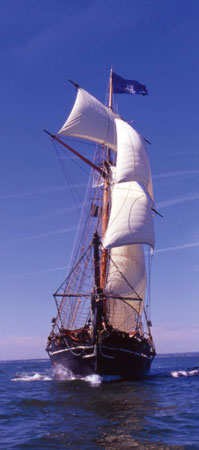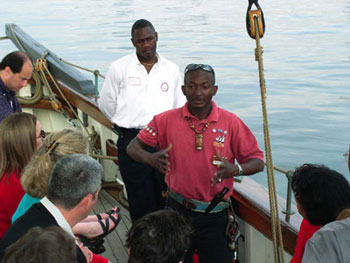
The Amistad: A Freedom Schooner
By Robert Hirsch
From Forever Young Magazine, August 9, 2003

|

Courtesy of Key Bank |
In 1839, fifty-three Africans were illegally kidnapped from West Africa (present day Sierra Leone) and sold into the transatlantic slave trade. The captives were transported to Havana and placed on the cargo schooner, La Amistad (ironically meaning friendship in Spanish), for transport to another part of the island. Three days into the journey the victims revolted and took over the ship. After sailing for 63 days the ship was seized and towed into the harbor of New London, CT. The Africans were jailed on murder charges. Their struggle became America's first human rights case, successfully argued before the United States Supreme Court by former President John Quincy Adams. The United Church of Christ and others involved in the anti-slavery movement raised money to pay for the captives' legal fees and helped repatriate the 35 survivors to Africa in 1841. Steven Spielberg's 1997 film by the same name brought world attention to this story.
On September 10 - 14, 2003, the 129-foot wooden recreation of this nineteenth century ship, operated by Amistad America, a non-profit organization, will be moored at the Erie Basin Marina on Buffalo's waterfront. For a modest admission, the public will be able to tour the Amistad. Dockside presentations by the crew will inform the public about the contributions of people of African descent. Also present will be two other boats, that can be board free of charge, and live entertainment. The captain of the Amistad, William "Bill" Pinkney, is the only African American and the fourth American to solo-circumnavigate the globe by sail via the Southern ocean Route under Cape Horn. Pinkney commands a diverse crew of twelve professional sailors who man the Amistad.
Recently national security adviser Condoleezza Rice reminded us "Africa is part of America's history. Europeans and Africans came to this country together,Africans in chains. And slavery was, of course, America's birth defect. And we've been trying to deal with the consequences of it ever since." Here in New York we often think of slavery as being a Southern problem, yet the 1790 U.S. census reported New York had 21,000 slaves out of a total population of 340,000 people and that freedom for all blacks in New York did not happen until Independence Day 1827.
The success of the Amistad case remains a historical milestone for the focus and strength that it brought to a budding abolitionist movement. It led to the formation of the American Missionary Association (AMA), which established more than 500 schools in the South before, during and after the Civil War including Fisk University, Hampton Institute, and Atlanta University. The AMA founded the Amistad Research Institute in 1966 to document the history of people of color in American and the struggle for civil rights and justice. The impetus for building the Amistad came from Warren Q. Marr II, former editor of the NAACP's The Crisis magazine, who wanted to foster unity among people of diverse background and improve race relations. The Amistad was constructed at the Mystic Seaport with help from students in Connecticut vocational schools and was launched in March 2000.The homeport for the Amistad is Long Wharf Pier in New Haven, Connecticut.
The Amistad Host Committee is chaired by former Buffalo Common Council President George K.Arthur and composed of community leaders including Buffalo State College President Muriel Howard who is chairing the Education Subcommittee, which is responsible for putting together a comprehensive interdisciplinary plan to involve educators and students in the Amistad story. Recently I talked with George Arthur about the visit and its ramifications in the Buffalo area. Here are excerpts from our conversation.

Courtesy of Key Bank |
Robert Hirsch: With its reputation as a segregated city, what is the significance of the Amistad visit for Buffalonians today?
George Arthur: The visit offers an unusual opportunity for Buffalo and Western New York to come together as a single community and think about the human issues of equality and justice that affect all of us. In the context of the first human rights trial in the United States, it is a chance to have a meaningful dialogue about race relations and how we can improve that relationship in Western New York.
RH: How does it connect with Buffalo's legacy as part of the Underground Railroad?
GA: It is a continuing lesson that it is possible for people, regardless of race, creed or color, to work together to improve the collective human condition.
RH: What is going to happen during the visit?
GA: The Amistad can serve as an icon and catalyst for teaching children the lessons of cooperation, justice, leadership, and perseverance. The vessel is a floating laboratory where young people of different backgrounds can learn the importance of working together. Each morning that the ship is here will be reserved for school visits. We hope that it will be a memorable experience for them and provide a living and lasting history lesson that carries over into their daily life.
RH: How might business, community, and religious leaders get together to deal social and economic issues that surround the Amistad project?
GA: To combat a lack of community involvement in these issues we are planning a Talk Back project that will engage people in discussion that will look for solutions that can help change the image and reputation of our area.
The Buffalo and Erie County Historical Society,KeyBank,Tops, Erie County, and United Church of Christ make the Amistad visit possible. Due to the limited size of the ship, it is highly recommended to get your tour tickets early to avoid disappointment. Tickets for the public will be time sold for every half hour from 1:00 PM to 6:00 PM at the cost of $5.00 for adults and $3.00 for children (mornings are reserved for school groups).
Detailed information about the Amistad can be found at: www.amistadamerica.org.
A driving tour of the Underground Railroad in the Buffalo Niagara region can be found at: www.buffalocvb.org/driving_tours_17.html
|